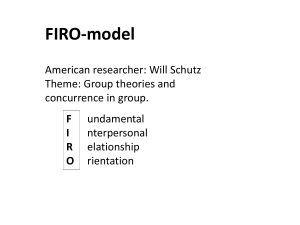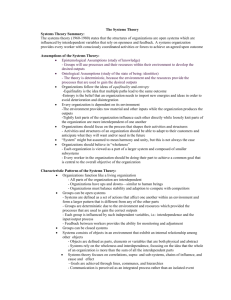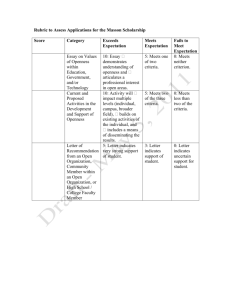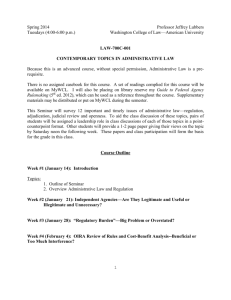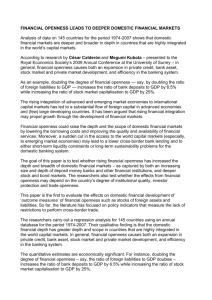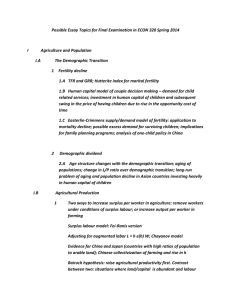Presentation - Open Reflections
advertisement
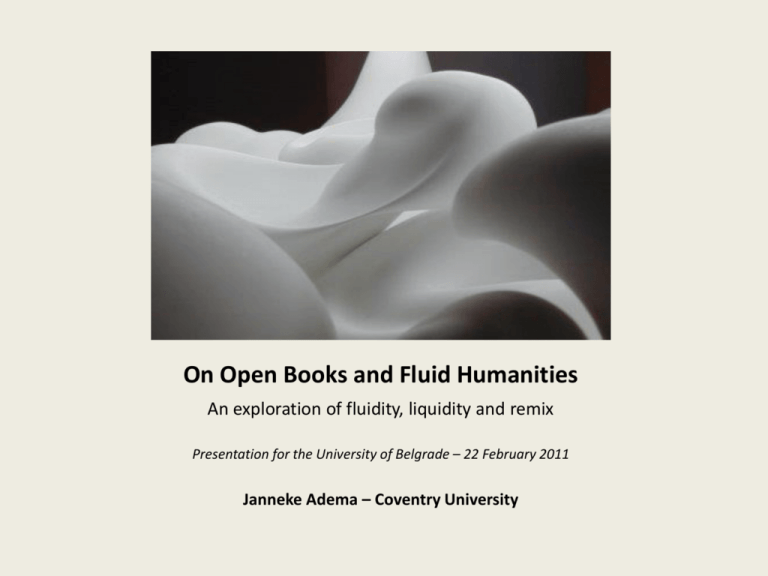
On Open Books and Fluid Humanities An exploration of fluidity, liquidity and remix Presentation for the University of Belgrade – 22 February 2011 Janneke Adema – Coventry University Structure • Part 1 – Openness explained • Part 2 – Openness in Theory and Practice Modularity The Selector The Archive • Part 3 – Fluidity deconstructed Part 1 – Openness Explained eBook users prefer to read on screen: 48% read solely on screen, 13% read only paper, while 39% say it depends. (CIBER’s Superbook project, Rowlands et al., 9 ) Springer’s eBooks survey shows usage figures of eBooks at between 58% and 80%, but offers no additional information about screen reading behaviour. (‘Springer, EBooks, the end-user perspective’ White paper produced by Springer 3) Part 1 – Openness Explained www.openhumanitiespress.org www.oapen.org Part 1 – Openness Explained “Openness” defined (?) Open Source Open Access Open Content Open Data Open … Part 1 – Openness Explained Various definitions of Openness Open Source Definition: http://www.opensource.org/docs/osd The definition of "open access" from the BOAI: http://www.soros.org/openaccess/read.shtml, The Open Knowledge Definition: http://www.opendefinition.org/okd/ Part 1 – Openness Explained Libre access / Openness to reuse Invoking what Lawrence Lessig calls a Read/ Write (RW) culture, as opposed to a Read/Only (RO) culture. Lawrence Lessig, Remix: Making Art and Commerce Thrive in the Hybrid Economy (London, 2008) 28-29. Part 1 – Openness Explained Fluidity, Liquidity and Remix Part 2 - Openness in Theory and Practice In the United States, the Copyright Act defines "derivative work" in 17 U.S.C. § 101: A “derivative work” is a work based upon one or more pre-existing works, such as a translation, musical arrangement, dramatization, fictionalization, motion picture version, sound recording, art reproduction, abridgment, condensation, or any other form in which a work may be recast, transformed, or adapted. A work consisting of editorial revisions, annotations, elaborations, or other modifications which, as a whole, represent an original work of authorship, is a “derivative work”. See: http://www.copyright.gov/title17/92chap1.html#101 Part 2 - Openness in Theory and Practice Lev Manovich ‘Helping bits move around more easily‘ Changes in Rothko’s painting’s average brightness over his career Part 2 - Openness in Theory and Practice “This shift is beyond anyone’s control, because the flow of information demands that individuals embed themselves within the actual space of critique, and use constant updating as a critical tool.” - Eduardo Navas Part 2 - Openness in Theory and Practice “The archive, then, legitimates constant updates allegorically. The database becomes a delivery device of authority in potentia: when needed, call upon it to verify the reliability of accessed material; but until that time, all that is needed is to know that such archive exists.” - Eduardo Navas Part 2 - Openness in Theory and Practice Part 2 - Openness in Theory and Practice • For the fluid text edition of Melvilles’s Typee, see: http://rotunda.upress .virginia.edu/melville/ Part 2 - Openness in Theory and Practice ‘The past, too, is a fluid text that we revise as we desire’. - John Bryant Part 2 - Openness in Theory and Practice ‘By masking the energies of revision, it reduces our ability to historicize our reading, and, in turn, disempowers the citizen reader from gaining a fuller experience of the necessary elements of change that drive a democratic culture.’ - John Bryant, The Fluid Text, 113 Part 2 - Openness in Theory and Practice See: http://liquidpub.org/ Part 2 - Openness in Theory and Practice “authors,” “editors,” “creators,” or “curators”, are just a means of ‘replacing one locus of power and authority (the author) with another (the editor or compiler)’. - Gary Hall Part 2 - Openness in Theory and Practice “Rather, wiki-communication can enable us to produce a multiplicitous academic and publishing network, one with a far more complex, fluid, antagonistic, distributed, and decentred structure, with a variety of singular and plural, human and non-human actants and agents.” - Gary Hall Part 3 – Fluidity deconstructed “A version can never be revised into a different work because by its nature, revision begins with an original to which it cannot be unlinked unless through some form of amnesia we forget the continuities that link it to its parent. Put another way, a descendant is always a descendant, and no amount of material erasure can remove the chromosomal link.” John Bryant, The Fluid Text, 85 Part 3 – Fluidity deconstructed See: http://www.futureofthebook.org/gamertheory2.0/?page_id=2 Part 3 – Fluidity deconstructed ‘The archive is never closed. It opens out of the future.’ - Jacques Derrida Part 3 – Fluidity deconstructed ‘It is from within these rules that we speak, since it is that which gives to what we can say.’ - Michel Foucault Part 3 – Fluidity deconstructed See: http://booktwo.org/notebook/wikipedia-historiography/ Part 3 – Fluidity deconstructed “All texts are fluid. They only appear to be stable because the accidents of human action, time and economy have conspired to freeze the energy they represent into fixed packets of language.” - John Bryant, The Fluid Text, 111 Part 3 – Fluidity deconstructed “(…) it is important to remember, however, that the values of stability, monumentality and authority, are themselves not entirely stable: they have always been interpreted in terms of the contemporary technology of handwriting or printing.” - Jay David Bolter Part 3 – Fluidity deconstructed “The Wikipedia phenomenon displays this widened range of possibilities in spectacular fashion. It also means that the notion of a final document loses much of its meaning because its finality can only be the result of a consensus, and not the product of a technology that fixes the text.” - Jean-Claude Guédon Part 3 – Fluidity deconstructed Anthologize: http://anthologize.org/ Janneke Adema: ademaj@uni.coventry.ac.uk www.openreflections.wordpress.com Twitter/Openreflections

